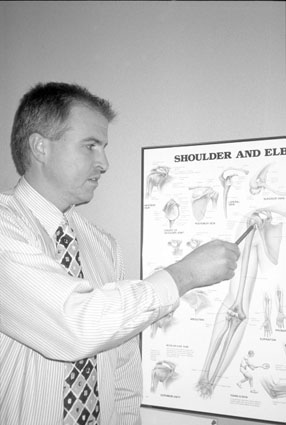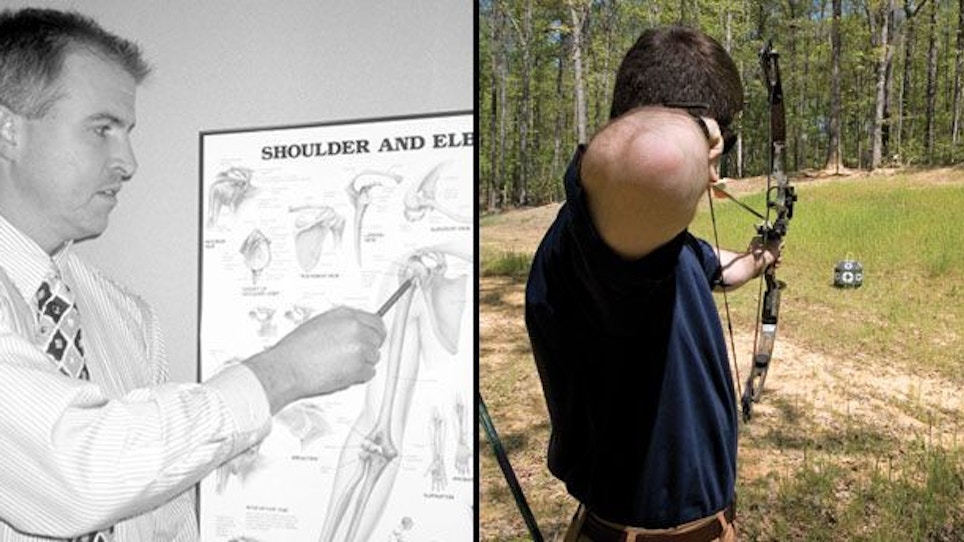 Dr. Mike Gibbons, an orthopedic surgeon and avid bowhunter, points out the weak link of the human body—the shoulder—for archers. |
A poll conducted by the international archery organization, FITA, revealed an alarming statistic: Shoot a bow, and you’re more prone to significant shoulder injury than a professional baseball pitcher. A whopping 47 percent of the respondents, which included archers world-wide, reported serious shoulder problems. Worse yet, most did not seek professional help.
That’s not surprising to me. Over the past three decades I’ve wrestled with deltoid strains, sprained ligaments and a rotator cuff tear. I’ve tried everything from anti-inflammatory drugs and cortisone shots to physical therapy and chiropractic sessions. And, lately, I’ve embarked on a comprehensive year-round preventive maintenance program. So if your shoulder complains the least bit when you shoot your bow, here are some factors to consider.
The Problem
Unfortunately, the simple act of shooting a bow is unnatural and stressful to the shoulders, and not exactly friendly to the forearms, elbows, wrists and fingers. It’s easy to take for granted the physical demands of drawing a bow. We don’t realize, for example, that shooting 50 arrows with a 60-pound bow means we’ve pulled 3,000 pounds in a relatively short period of time. The upper-body also takes a beating when an arrow is released—the sudden loss of holding weight eventually takes its toll. This is not good news for the shoulder, whose primary function is mobility, not stability. No wonder repeated exertion—mastering archery requires plenty of practice—often leads to breakdowns.
As taxing as recreational and competitive archery can be, bowhunting introduces another variable that increases the likelihood of injury: effective muscle warm-up, to encourage flexibility, is impractical in real-world hunting conditions. Add it all up and it’s no wonder muscles, ligaments and tendons are taxed to the max by bows and arrows.
Still, the real problem isn’t archery. It’s archers. While the human body is a marvelous creation, capable of providing many years of pain-free service, the typical archer lacks conditioning and training. Fact is, most archery-related injuries are the result of weak (or inflexible) muscles, poor shooting mechanics, and simply overdoing it.
Assessment & Rehab
The starting point is accurately assessing your physical condition. First and foremost, do you experience any pain when shooting your bow? The sensation may range from a subtle, dull ache to an acute zinger if you move the “wrong” way. A good test is lifting both arms to a parallel position (90º) while standing erect. If you feel the slightest twinge, better seek medical help; that pain is trying to tell you something.
I was “living with” minor shoulder pain; however, after digesting the research, I decided to visit a specialist at a major clinic in my hometown. “As your survey [points out], most archers fail to get medical advice,” says Dr. Mike Gibbons, an orthopedic surgeon and avid bowhunter. “That’s really unfortunate because in the vast majority of cases we can help.”
A central theme of rehabilitation typically includes medication to reduce pain and inflammation and improve flexibility. Coincidentally, anti-inflammatory drugs (NSAIDs), such as Celebrex and Vioxx, are marketed for arthritic-type symptoms and are reportedly stronger than aspirin and ibuprofen (dosage is one pill per day) without the customary gastro-intestinal side-effects. While these brands work on the same principle, known as COX-2 inhibitors, one may produce better results than the other, so be sure to discuss this with your doctor. An over-the-counter “remedy,” glucosamine sulfate, has its share of loyal followers. “There’s no evidence to support or invalidate it,” reports Dr. Gibbons, “but if it appears to help, I’m all for it.”
Range-of-motion exercises, tailored to a patient’s individual needs, are critical. Daily sessions with a Thera-Band (over-sized rubber band I tied to a door knob) were designed to improve my flexibility and stability. Push-ups helped, too.
Sometimes surgical repair is appropriate; torn muscles must be sewn back into place before the shoulder can function properly again. But not all tears require surgery. Former Arizona Diamondbacks pitcher, Todd Stottlemyre, is also an avid bowhunter (especially for elk) who suffered a partial tear of his right shoulder. But instead of going under the knife, Stottlemyre adopted an intense rehabilitation program that included resistance training (weights) and range-of-motion exercises. It worked, enabling him to regain his old form (better yet, he didn’t miss a single elk season).
Next: Preventative Maintenance
Have you ever had a hunting-related injury? What happened and how did you treat it?






